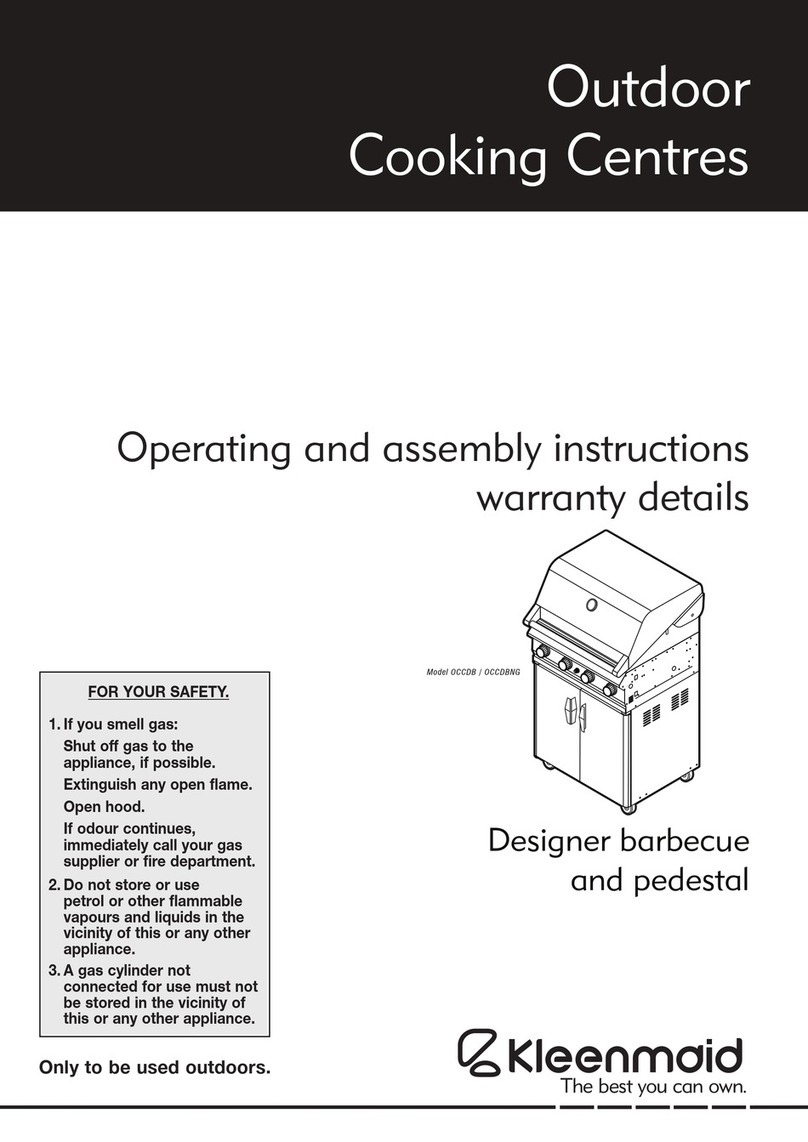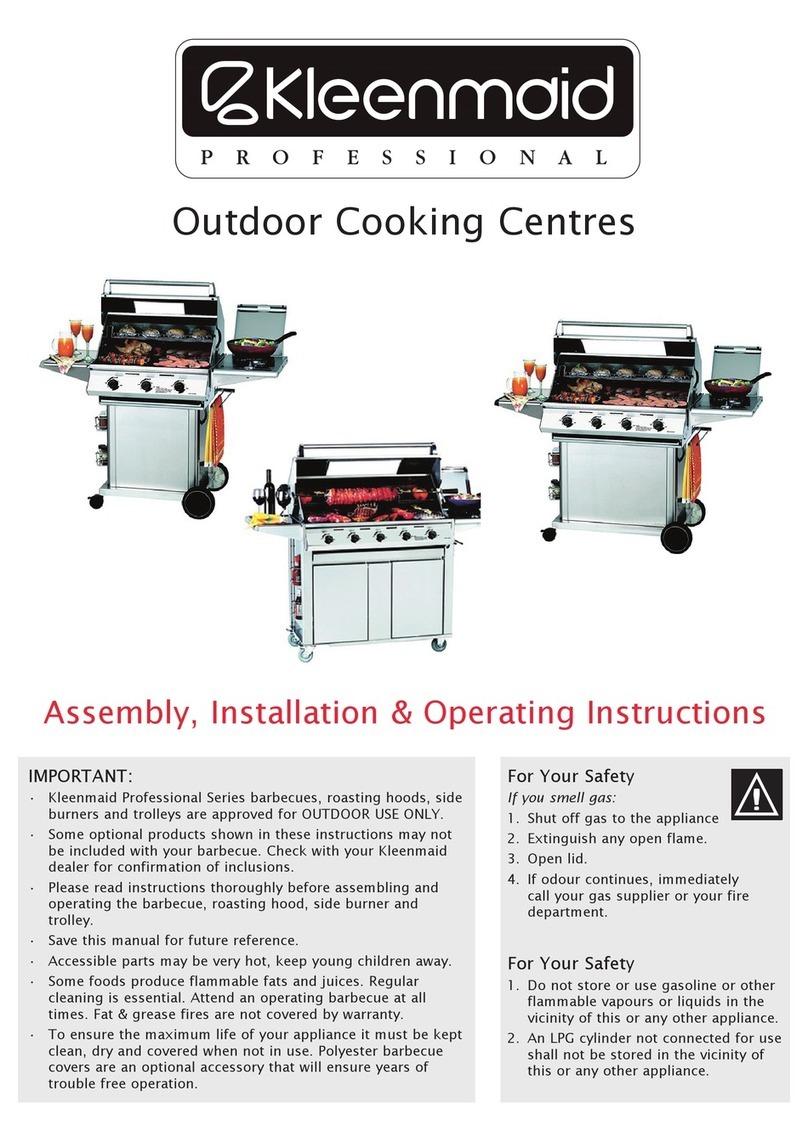SAFETY
44
FOR YOUR SAFETY:
• DO NOT STORE OR USE PETROL OR
OTHER FLAMMABLE VAPOURS AND
LIQUIDS IN THE VICINITY OF THIS OR ANY
OTHER APPLIANCE.
• DO NOT STORE EMPTY OR FULL SPARE
GAS CYLINDERS UNDER OR NEAR THIS
OR ANY OTHER APPLIANCE.
• KEEP THE GAS HOSE AWAY FROM HOT
SURFACES. PROTECT GAS HOSE FROM
DRIPPING GREASE.
AVOID UNNECESSARY TWISTING OF
HOSE. VISUALLY INSPECT HOSE PRIOR TO
EACH USE FOR CUTS, CRACKS, EXCES-
SIVE WEAR OR OTHER DAMAGE.
REPLACE HOSE, IF NECESSARY.
• NEVER TEST FOR GAS LEAKS WITH A LIT
MATCH OR OPEN FLAME.
• NEVER LIGHT APPLIANCE WITH LID
CLOSED.
• NEVER LEAN OVER COOKING
SURFACE WHILE LIGHTING APPLIANCE.
• USE GOOD QUALITY INSULATED OVEN
MITTS WHEN OPERATING APPLIANCE.
• NEVER ALTER OR MODIFY THE
REGULATOR OR GAS SUPPLY ASSEMBLY.
• THIS APPLIANCE MUST NOT BE USED
INDOORS.
DANGER – IF YOU SMELL OR HEAR
THE HISS OF ESCAPING GAS FROM
THE GAS CYLINDER:
• KEEP CLEAR OF THE GAS CYLINDER.
• TURN ALL CONTROLS ON THE
APPLIANCE TO ‘OFF’.
•EXTINGUISH ANY OPEN FLAME.
•REMOVE LID OR OPEN HOOD.
•IF ODOUR CONTINUES, IMMEDIATELY
CALL YOUR GAS SUPPLIER OR FIRE
DEPARTMENT.
READ CAREFULLY BEFORE
ASSEMBLING AND OPERATING
YOUR OUTDOOR RANGE BARBECUE.
NEVER CONNECT AN UNREGULATED
GAS CYLINDER TO THIS APPLIANCE.
• NEVER STORE YOUR
GAS CYLINDER INDOORS.
• FOR STORAGE AND CYLINDER
EXCHANGE, DISCONNECT HOSE AT THE
CYLINDER ONLY –
DO NOT DISCONNECT HOSE FROM
THE APPLIANCE.
DO NOT use this appliance in garages, porches, breezeways, sheds or
other enclosed areas. The Outdoor Range barbecue is to be used
OUTDOORS ONLY. Refer to page 6. It is not intended to be installed in
or used on recreational vehicles and/or boats and should not be placed
under any surface that will burn. Do not obstruct the flow of combustion
and ventilation air around the appliance housing while in use.
LOCATION OF YOUR OUTDOOR RANGE
Keep children away from this appliance during use and until it has cooled
after you are finished. Do not allow children to operate appliance or to
swing on handle.
PROTECT CHILDREN
The gas cylinder should be filled by a reputable gas dealer, or exchanged at
a reputable gas cylinder exchange outlet. Gas cylinders should be
visually inspected and re-qualified periodically.
Always keep gas cylinder in an upright position. Always close the
cylinder valve when the appliance is not in use.
Do not subject the gas cylinder to excessive heat.
If you store this appliance indoors, ALWAYS disconnect and remove gas
cylinder FIRST, and store gas cylinder safely outside. Gas cylinders
must be stored outdoors in a well ventilated area out of reach of children,
and must not be stored in a building, garage or any other enclosed area.
This is a low pressure appliance and must only be used with the hose and
regulator supplied.
This appliance is designed for use with a 9 kg gas cylinder. Ensure
gas cylinder conforms to Australian Standard AS2469 and is less than 10
years old.
DO NOT CONNECT THIS APPLIANCE TO A GAS
CYLINDER LESS THAN OR EXCEEDING THIS CAPACITY.
GAS CYLINDER USE AND APPLIANCE SAFETY
SERVICING
ANY OF THE FOLLOWING SIGNS MAY
INDICATE THAT THE APPLIANCE IS NOT
OPERATING PROPERLY AND MAY NEED
SERVICING:
•EXCESSIVE YELLOW FLAME.
•IRREGULAR SIZE OF FLAME
ACROSS BURNER.
•‘POPPING’OF FLAME.
•SOOTING.
•ABNORMAL NOISE(S).
•HISSING SOUND.
NOTE: Before requesting service,
please refer to page 15 ‘Fault Finding’.
NEVER TEST FOR LEAKS WITH A FLAME.
Prior to first use, and at the beginning of each new season (or, if using
bottled gas, whenever gas cylinder is changed), you must check for gas
leaks. Follow these steps:
1. Make soap solution by mixing one part liquid detergent and one
part water.
2. Turn burner control(s) to ‘OFF’, then turn on gas at source.
3. Apply the soap solution to all visible and accessible gas connections
including the gas cylinder. Bubbles will appear in the soap solution
if connections are not properly sealed. Tighten or rectify as necessary.
Refer to page 5 for further details.
4. If you have a gas leak you cannot rectify, turn off the gas at the
source. Contact the manufacturer for assistance.
Refer to back cover.
CHECKING FOR GAS LEAKS































